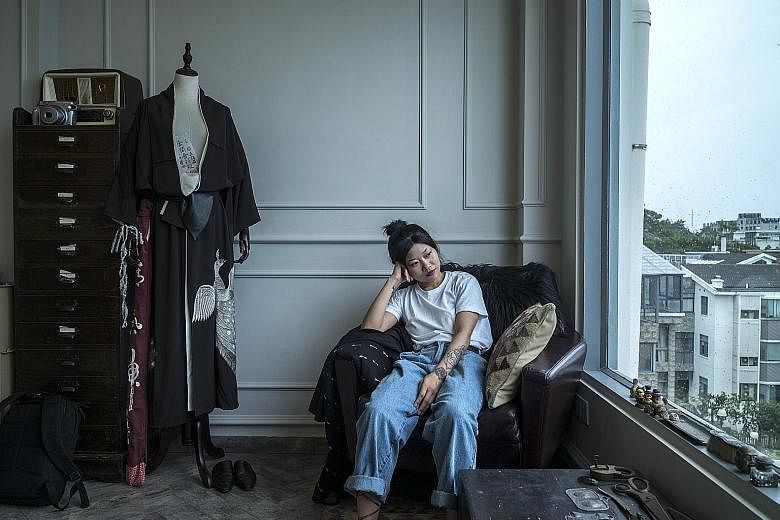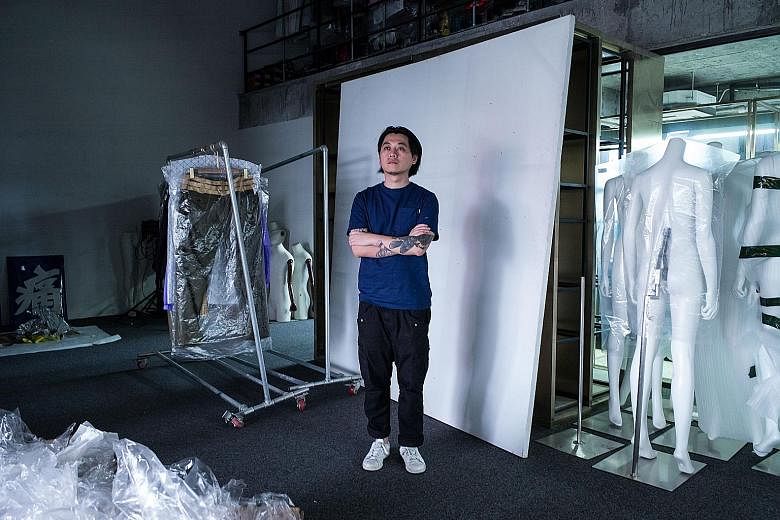XIAMEN • In the seven years she lived in Beijing, Vega Zaishi Wang started her eponymous label and made her name as one of China's top young fashion designers.
But the hectic pace of life - the media, parties, pollution and cost of living - was taking its toll.
She struggled with depression so oppressive, she named her 2014 autumn/winter collection The Dark Night Of The Soul.
In September, she finally made her escape to Xiamen, a coastal city between Hong Kong and Shanghai.
She set up a studio in a four-storey mansion in a quiet neighbourhood on Xiamen Island, just a short walk from the beach.
"In Beijing, there was no such thing as work-life balance," said Wang, 32. "But here in Xiamen, I can slow down my pace and focus on my collections."
In moving there, she became the latest addition to a small but robust community of young Chinese fashion designers who have forgone the glamour of Shanghai and Beijing in favour of Xiamen.
Known as the "Xiamen gang", these designers - whose aesthetics range from streetwear to high-end - have showcased their craft in London and Paris and even inspired knockoffs on Chinese e-commerce portals such as Alibaba's Taobao.
Besides Wang, they include Shangguan Zhe of Sankuanz and Liu Min of Ms Min.
All three were featured last year in Opening Ceremony's Year Of China, for which the influential New York-based fashion retailer highlighted a select group of emerging Chinese designers.
Together, the designers are behind some of the most cutting-edge trends coming out of China. That strikes many as curious, given they are working out of a city where the concept of fashion seems to be an afterthought.
"Xiamen is a place that doesn't have any fashion," said Dido Liu, founder of Xiamen-based brand Deepmoss. "It's so hot, most people just go out wearing T-shirts, shorts and flip-flops."
The term "chill" comes up often in discussions about Xiamen.
Visitors stroll along boulevards lined with stately colonial buildings, the legacy of 19th-century European traders who once frequented the port of Xiamen - then known as Amoy - to exchange sugar and opium for Chinese tea and porcelain.
The more adventurous wander through Bashi, a bustling seafood market where fishermen drop off their daily hauls, or meander around Shapowei, an art zone that comes alive at night with skateboarders and small vendors selling handmade jewellery and crafts.
Thank You Cafe in Shapowei, started by designer Cotton Yu of Mymymy, is a favourite watering hole for the fashion gang.
Residents often converse in Hokkien. In language, culture and atmosphere, the city more closely resembles Taiwan, which is within swimming distance of Xiamen.
But it is precisely Xiamen's laid- back vibe that attracts designers.
"Xiamen is one of those rare cities where you can work really hard and get a lot done, but you can also relax," said Mr Ian Hylton, president of Ms Min and former creative director of menswear for Ports, which maintains its China headquarters in Xiamen.
Unlike Wang, who sought out Xiamen as a refuge, the other designers in the Xiamen gang settled here more by circumstance.
Many, including Zhe, Dido Liu of Deepmoss and Liu Min of Ms Min, grew up in the region.
But what keeps them here is more than inertia. Operation costs can be much lower than those in Shanghai and Beijing.
Wang estimated that she paid one-quarter of what she would pay to rent a comparable studio space in Beijing. Skilled employees, such as machinists, are also easier to find, given the region's history as a garment-manufacturing hub.
Local designers can also apply for generous rent subsidies from the city government, eager to promote the place as a fashion hub.
But subsidies can come with challenges. Designers are often pressured to participate in local government-sponsored fashion events.
Accepting the benefits also subjects designers to strict regulations that often do not take into account the nuances of the business.
Wan Yifang discovered that reality recently when officials seized the sewing machines in her small subsidised studio space as a violation of the building's fire code prohibiting production.
"The government doesn't really know what it's doing," said Wan, who is looking for a new studio.
"Design studios are really a new thing for them. They've never thought about how to differentiate between large-scale manufacturers and small design studios."
Still, such drawbacks are minimal when compared with the relaxed lifestyle.
The ease of communication platforms such as Tencent's WeChat and frequency of flights out of Xiamen have further bridged the gap, allowing local designers to tap what has become a fast-moving fashion revolution in China, a country that just one generation ago had little option but to wear sombre-coloured Mao suits.
NYTIMES


